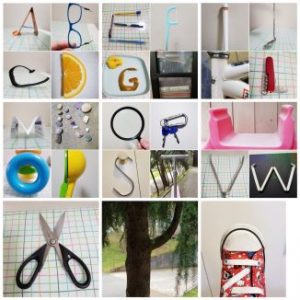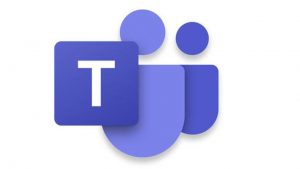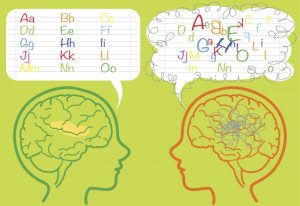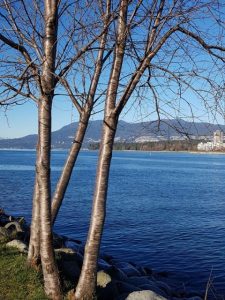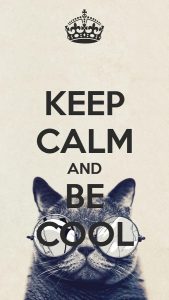Term Three Overview, Spring 2020
To tie the big ideas from our curriculum together into a larger, enduring understanding,
we studied subject areas through the lens of a universal, conceptual theme.
CONCEPTS: SYSTEMS and INTERDEPENDENCE
Unit focus statement:
Humans create a variety of systems and tools to get their needs and wants met.
Remote Learning — Keep Learning, Stay Connected!:
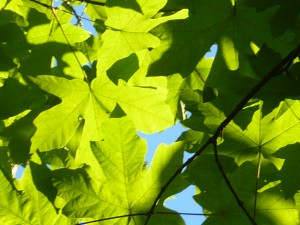 Division 5 did a great job of continuing their learning and staying connected, even though not at school. Students participated in unit discussions and completed learning opportunities through online tools such as MS Teams, Zoom, E-Portfolios, SoundTrap, Excel, PowerPoint, EPIC, Open School BC, IXL, Prodigy, and more.
Division 5 did a great job of continuing their learning and staying connected, even though not at school. Students participated in unit discussions and completed learning opportunities through online tools such as MS Teams, Zoom, E-Portfolios, SoundTrap, Excel, PowerPoint, EPIC, Open School BC, IXL, Prodigy, and more.
I am proud of how everyone did their best to adjust to a new way of communicating and learning. We all learned new technology tools and tricks!
Students created independent schedules to follow at home based on these categories:
- MAKER HOUR (ADST/ART),
- FITNESS HOUR (stay active),
- GENIUS HOUR (passion projects),
- INDIE READING (read EPIC),
- SERVICE & CONNECTION (connect with classmates or help at home), and
- UNIT HOUR (LA, Math, socials, science).
An activities list using these categories was provided each week on the blog to follow.
Unpacking the Unit:

Each week, I met with seven smaller groups of 3-4 students each, and we rotated participants to allow for cross-pollination of ideas. We structured meetings by pondering 1-2 inquiry questions. For example, in our first meeting, we asked, “What is the issue with toilet paper?”
We defined needs versus wants, then identified problems arising from our current situation for getting those needs and wants fulfilled. This led to discussion of curriculum content such as natural resources, scientific knowledge needed to gain resources (geography, geology, chemistry), economics, and financial literacy.
Afterwards, students engaged in related learning opportunities in MS Teams, as I monitored and prompted deeper discussion of unit topics. I was impressed with students’ application of core competencies during online work as they learned to support discussions respectfully, to communicate critical thinking about unit topics, and to use creative thinking to invent new ways to connect with one another.
Socials:
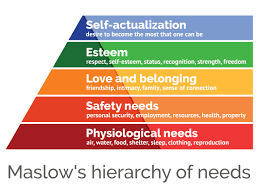 Students completed a brainstorm of their own needs and wants, then shared it in small-group discussions. We expanded the list by reviewing Maslow’s Hierarchy of Needs, and then identified systems humans have created to fulfill basic needs and to provide social-emotional support for communities.
Students completed a brainstorm of their own needs and wants, then shared it in small-group discussions. We expanded the list by reviewing Maslow’s Hierarchy of Needs, and then identified systems humans have created to fulfill basic needs and to provide social-emotional support for communities.
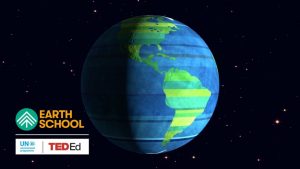
To get needs and wants fulfilled, we use a lot of renewable and non-renewable resources! What are they? Which ones do we use the most? How do they get to us? Are there problems with our use of resources? Students did a scavenger hunt in their homes, and we concluded minerals are used more than any other resource to make the things we use!
Through the TED-Ed Earth School program online, students viewed videos designed to prompt discussion about sustainability, such as how many resources are used to make smartphones, the environmental and health costs of using plastics, and agricultural practices to support food security for everyone. The video that provoked the most discussion explained how humans could expand their use of insects as a source of protein!
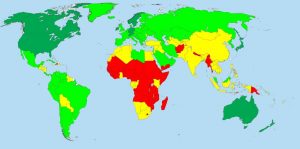 We also talked about the inequitable distribution of resources in the world — why some countries are richer than others, and why 1% of the population in many countries has 99% of the wealth. To understand how this problem relates to the concepts of systems and interdependence, we discussed economics, quality of life, government, and the geographical, political, and cultural factors that can impact a nation’s wealth and overall well being.
We also talked about the inequitable distribution of resources in the world — why some countries are richer than others, and why 1% of the population in many countries has 99% of the wealth. To understand how this problem relates to the concepts of systems and interdependence, we discussed economics, quality of life, government, and the geographical, political, and cultural factors that can impact a nation’s wealth and overall well being.
Students then conducted independent research on topics of passion from the unit. They worked in small, collaborative groups on MS Teams to make PowerPoint presentations to share with peers.
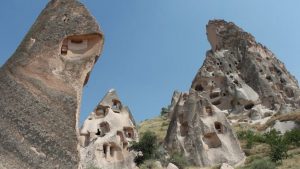 If minerals are used more than any other resource in our homes, how do we find them? What kind of scientific knowledge is required to find all the building blocks of items we use? We were all surprised by the number of minerals used in everyday items, such as toothpaste, drywall in our homes, toilets, paints, and electronics.
If minerals are used more than any other resource in our homes, how do we find them? What kind of scientific knowledge is required to find all the building blocks of items we use? We were all surprised by the number of minerals used in everyday items, such as toothpaste, drywall in our homes, toilets, paints, and electronics.
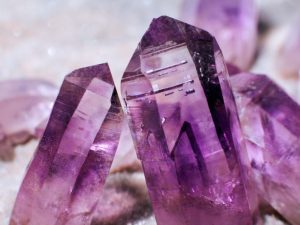 To better understand this, we started at the beginning. First, what is the difference between a rock, a mineral, and an element? What are the different types of rocks? Where would you find them? What are the geological processes that create the minerals we need?Students read Geology of the Pacific Northwest on EPIC to learn about the basics of geology.
To better understand this, we started at the beginning. First, what is the difference between a rock, a mineral, and an element? What are the different types of rocks? Where would you find them? What are the geological processes that create the minerals we need?Students read Geology of the Pacific Northwest on EPIC to learn about the basics of geology.
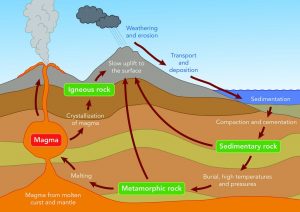 We discussed the rock cycle, plate tectonics, the geological history of British Columbia, and how geologists make careful observations to determine the land’s story. Who knew the Rocky Mountains were once under the ocean? Did you know we have volcanoes very near to where we live? Why is the rock on Vancouver Island different from that of Vancouver Mainland?
We discussed the rock cycle, plate tectonics, the geological history of British Columbia, and how geologists make careful observations to determine the land’s story. Who knew the Rocky Mountains were once under the ocean? Did you know we have volcanoes very near to where we live? Why is the rock on Vancouver Island different from that of Vancouver Mainland?
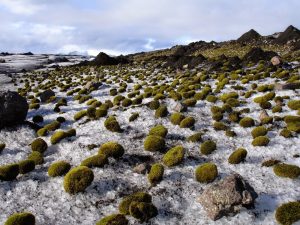 We read Old Rock is Not Boring, and reflected on how every rock has an amazing story! Ms. D posted daily “Guess the Rock’s Story” challenges, as students tried to figure out the names of rocks and minerals in Ms. D’s personal collection, where they came from, and how they formed. Ms. D’s brother contributed pictures from his travels, as he is a rock hound, too, so we were fortunate to look at rock formations as far away as Iceland and Turkey.
We read Old Rock is Not Boring, and reflected on how every rock has an amazing story! Ms. D posted daily “Guess the Rock’s Story” challenges, as students tried to figure out the names of rocks and minerals in Ms. D’s personal collection, where they came from, and how they formed. Ms. D’s brother contributed pictures from his travels, as he is a rock hound, too, so we were fortunate to look at rock formations as far away as Iceland and Turkey.
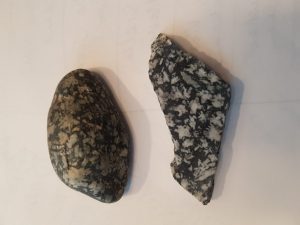 During ZOOM meetings as a whole class, Ms. D presented experiments and guessing games designed to help understand how the periodic table is related to geology; the difference between an element and a mineral; how the rock cycle involves changes in matter through physical and chemical forces such as erosion, heat, pressure, and the bonding of elements; and how rocks form out of cooling liquid magma.
During ZOOM meetings as a whole class, Ms. D presented experiments and guessing games designed to help understand how the periodic table is related to geology; the difference between an element and a mineral; how the rock cycle involves changes in matter through physical and chemical forces such as erosion, heat, pressure, and the bonding of elements; and how rocks form out of cooling liquid magma.
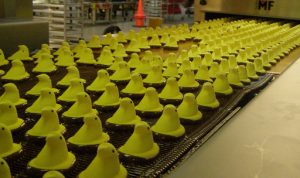 We pretended PEEPS (weird marshmallow treats available in April) were taking over the planet, and that the PEEP Elimination Council had asked us to destroy them using only household materials. We brainstormed things that could easily dissolve PEEPS! Ms. D took everyone’s ideas, put volunteer PEEPS into solutions, and showed everyone the results!
We pretended PEEPS (weird marshmallow treats available in April) were taking over the planet, and that the PEEP Elimination Council had asked us to destroy them using only household materials. We brainstormed things that could easily dissolve PEEPS! Ms. D took everyone’s ideas, put volunteer PEEPS into solutions, and showed everyone the results!
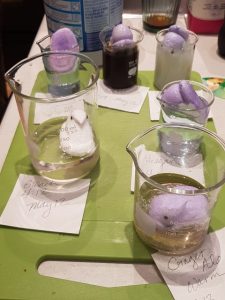 We found out, amazingly, that hot water worked best! This experiment led to great discussion about what things can break down chemical bonds to make a solid turn into a liquid solution. HEAT is very effective, because cold water did nothing to a PEEP.
We found out, amazingly, that hot water worked best! This experiment led to great discussion about what things can break down chemical bonds to make a solid turn into a liquid solution. HEAT is very effective, because cold water did nothing to a PEEP.
We also made Borax crystals to discuss super-saturated solutions. We learned how the cooling process of hot magma results in the formation of crystals — like the ones that appear when you make Borax crystals at home!
Congratulations to Division 5 for amazing questions and discussions after our experiments. I think we have many future geologists in the group!
Language Arts:
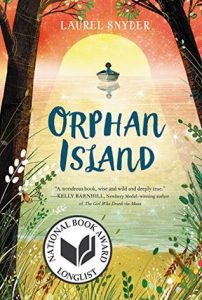 As students communicated ideas about the unit, they focused on strengthening prose with appropriate comma use, dialogue, paragraphing, detailed descriptions, and complex sentences with conjunctions and transitions. Students completed Quick Write challenges each week, using John Spencer’s creative writing prompts such as designing a school for ninjas or telling the story of a lost shoe. Students can be proud of their amazing stories, full of interesting vocabulary and literary devices such as personification.
As students communicated ideas about the unit, they focused on strengthening prose with appropriate comma use, dialogue, paragraphing, detailed descriptions, and complex sentences with conjunctions and transitions. Students completed Quick Write challenges each week, using John Spencer’s creative writing prompts such as designing a school for ninjas or telling the story of a lost shoe. Students can be proud of their amazing stories, full of interesting vocabulary and literary devices such as personification.
As part of MAKER HOUR, students listened to podcasts and analyzed how they are different from other types of oral storytelling and personal narratives. They used a planner to structure their own podcasts, recording them in SoundTrap and sharing them with the group. Some students even chose to work together, organizing their own Zoom meetings to collaborate on scripts.
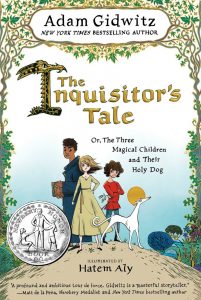 We all enjoyed our daily read aloud sessions of Orphan Island and The Inquisitor’s Tale, and some students decided to collaborate together independently through One Drive to write an Orphan Island Part 2, to answer the many lingering questions about the island’s history! Students engaged daily in creative writing through prompts in our “Writing Challenges Channel” on MS Teams, making funny haikus about social distancing or writing collaborative fantasy stories.
We all enjoyed our daily read aloud sessions of Orphan Island and The Inquisitor’s Tale, and some students decided to collaborate together independently through One Drive to write an Orphan Island Part 2, to answer the many lingering questions about the island’s history! Students engaged daily in creative writing through prompts in our “Writing Challenges Channel” on MS Teams, making funny haikus about social distancing or writing collaborative fantasy stories.
Math:
 Financial literacy was the key focus of our numeracy studies, which connected well with discussions about resource management, wealth, and economics.
Financial literacy was the key focus of our numeracy studies, which connected well with discussions about resource management, wealth, and economics.
Each student pretended they were living on their own and brainstormed all of the things they would have to pay for independently! They received a job assignment with a salary, and they had to create a monthly, personal budget, taking into consideration rent/mortgage, electrical bills, wifi costs, transportation, food, taxes, savings, and incidentals. Many students experimented with MS Excel for the first time and used it to present their budget information.
As part of understanding money, we discussed proper notation, currency exchange, and why currencies are different between countries. We talked about taxes, both those taken off of salaries and those paid at stores, and how those monies are used to pay for services we enjoy at each level of government.
Students were given opportunities to practice adding, subtracting, multiplying, and dividing decimal money amounts, according to their grade level, and we discussed percentages and how they work when giving a tip at a restaurant or reading ads about store discounts. Further practice of skills was provided online, using IXL Math.
Through our “Math Challenges” channel, students completed Difficult Math Riddles, as well as word problems from Perfectly Perilous Math and School of Math.
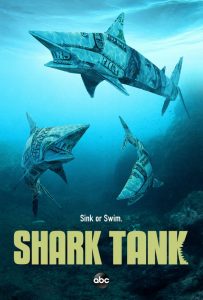
To show their understandings of financial literacy and marketing ideas, students designed a product to sell at a pretend SHARK TANK show. They were asked to design a product, give it a slogan, logo, and brand name, and then make a presentation about its use and production costs to potential investors. We had a lot of creative ideas like gerbil carriers, water filters, memory accumulators, storage organizers, and more!
ADST:
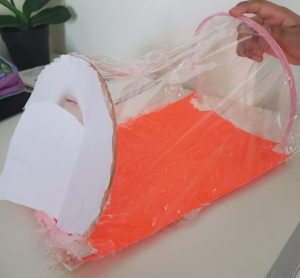
The year was full of opportunities to use the design cycle, which includes defining a problem, ideating, prototyping, testing, making, and sharing. Here is an example — a gerbil carrier created as a MACC Mall product!
Students:
- learned new tools such as SoundTrap, as they designed and recorded podcasts,
- used the Book Creator application to make illustrated books on unit topics,
- presented and organized ideas using Microsoft Excel and PowerPoint,
- created products for MACC Mall and presented ideas to a pretend Shark Tank
- made board games to show learning about human body systems,
- applied geometry and measurement knowledge to create a tiny house model
- participated in the Hour of Code to design and code games using Scratch,
- learned how to program Micro:Bits on the laptop to create mini digital devices,
- experimented with making electrical circuits through Scrappy Circuits building,
- collaboratively designed Rube Goldberg machines and marble roller coasters, and taught younger children at school to create them, as well,
- described their design process using e-portfolios and picture documentation,
- demonstrated a willingness to work with new materials, to collaborate with others in developing ideas, and to safely store tools and technologies used, and
- during remote learning, found their own MAKER HOUR activities to do such as making forts, coding games, and building new creations at home.
Independent Project and Career Education:
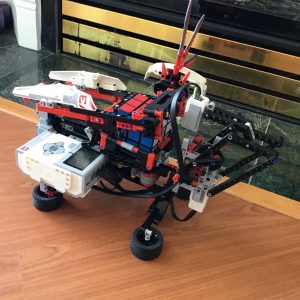
By February, most students had selected topics for independent study. They were allowed to select any topic as long as it was something they sincerely cared about!
During each project this year, we developed curricular competencies to help with a successful independent inquiry.
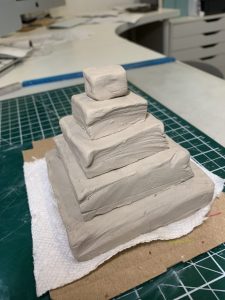
These skills can be found in almost every aspect of the curriculum, including career education, social studies, language arts, science, fine arts, and applied design. Here is a quick summary:
- Understanding passions and making a commitment to pursue personal interests
- Project management, goal setting, and meeting deadlines
- Self-management as they monitor their time during open work periods
- Asking questions that further an inquiry, including open and closed questions
- Documenting and organizing research through notes and a bibliography
- Searching online effectively, including finding reliable and safe resources
- Using critical thinking to analyze resources and summarize findings
- Communicating findings in writing and through public speaking
- Applying creative thinking by sharing results through a variety of media
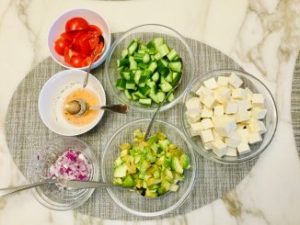
I was especially impressed with our primary research done this year, from experimenting with a vegan menu at home, building a pyramid using ancient math from Egypt and Greece, and constructing robots to study artificial intelligence. There are too many to mention!
Our independent projects from 2020 can be found on this page, which is available for the community on Friday, June 12th.
Physical and Health Education, Career Education:
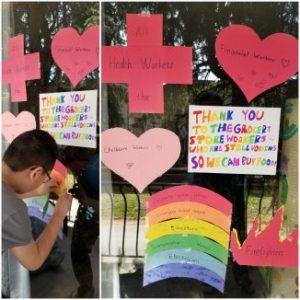 During FITNESS HOUR, students committed to get moving and to find balance away from the screen during their day. Many participated in dance, tennis, or fitness programs through extra curricular activities that continued online via Zoom during their time at home. Students also created a shoe workout made for small spaces, and created a social-distancing sport, sharing both with the group online.
During FITNESS HOUR, students committed to get moving and to find balance away from the screen during their day. Many participated in dance, tennis, or fitness programs through extra curricular activities that continued online via Zoom during their time at home. Students also created a shoe workout made for small spaces, and created a social-distancing sport, sharing both with the group online.
For SERVICE & CONNECTION, students created art to celebrate essential service workers, helped one another with projects, connected with friends over ZOOM, helped parents care for younger siblings, and tried cooking and baking healthy food, some for the first time.
Students completed digital citizenship modules online to learn about how to protect privacy and to communicate effectively on social media or MS Teams.
Overall, they reached out to one another to maintain our class community, and many were successful applying self-regulation strategies to stay productive and engaged in learning.
Fine Arts:
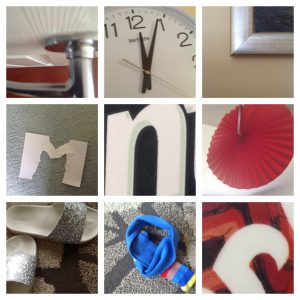 Students took amazing photographs this spring! We focused on learning the elements and principles of photography, particularly line, shape, colour, and perspective. During photo challenges, they looked at famous photos and tried to replicate the technique used, such as taking photos from the perspective of a small animal, creating a story through a photo, or making something look smaller by positioning the camera in a specific way.
Students took amazing photographs this spring! We focused on learning the elements and principles of photography, particularly line, shape, colour, and perspective. During photo challenges, they looked at famous photos and tried to replicate the technique used, such as taking photos from the perspective of a small animal, creating a story through a photo, or making something look smaller by positioning the camera in a specific way.
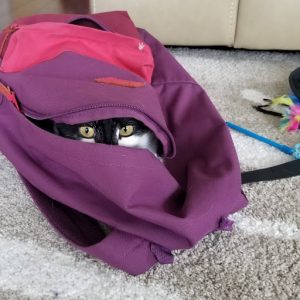
They reviewed the history of photography and experimented with composition techniques, including the creation of a photographic collage.
You can see their amazing photography in a slideshow that was sent home to view!
Overall, despite how different our time was in Spring 2020, students were able to produce creative work and maintain connections with classmates and community. Thank you for all of your hard work, Division 5, and have a great summer!

